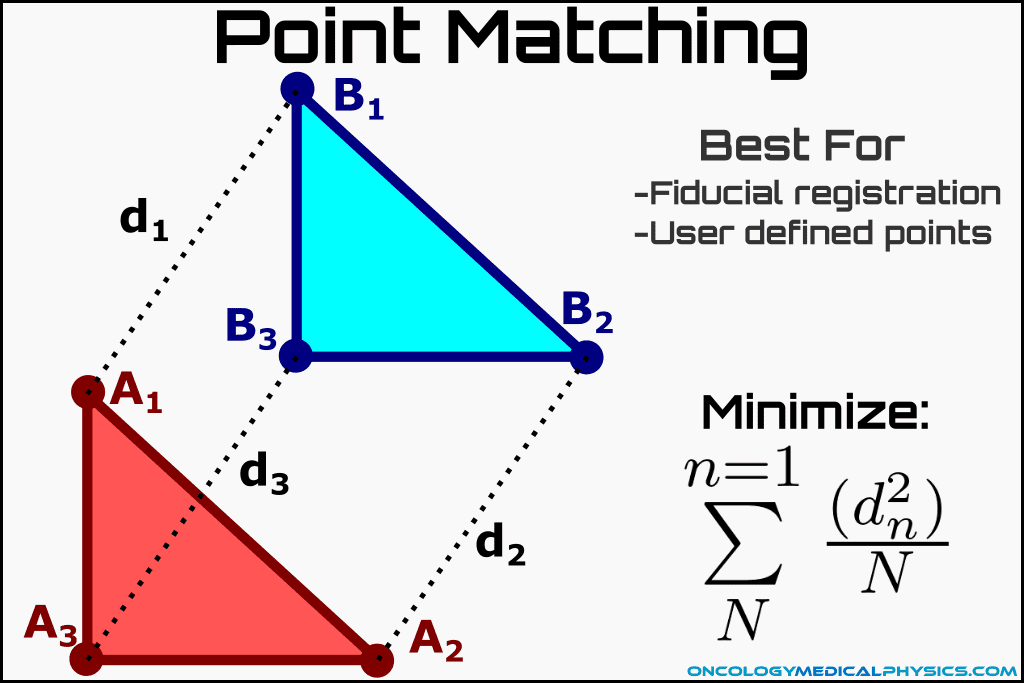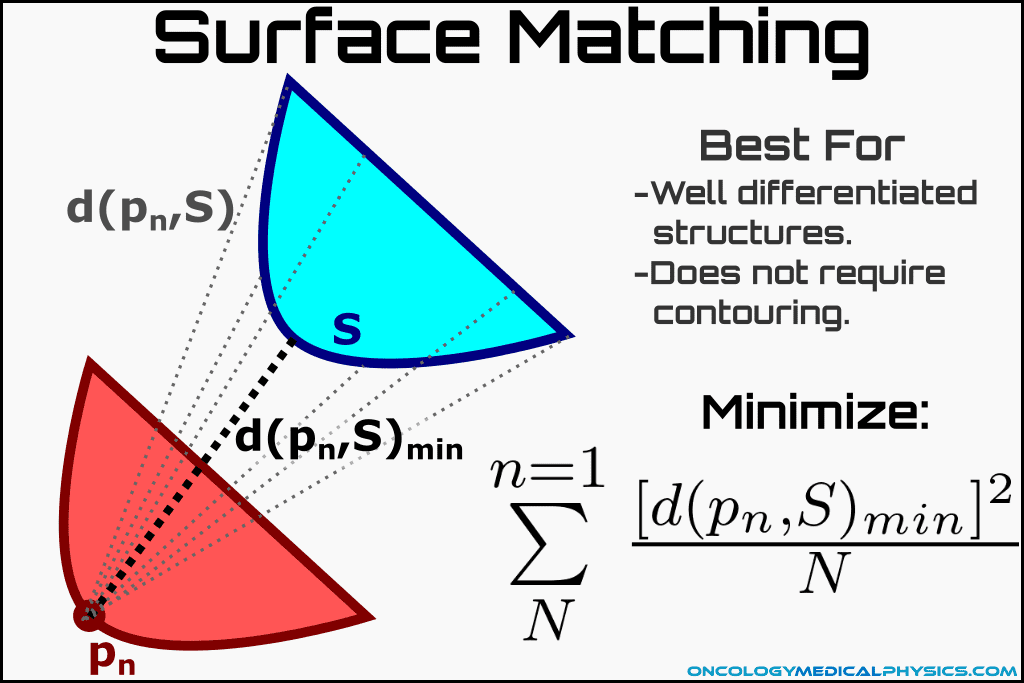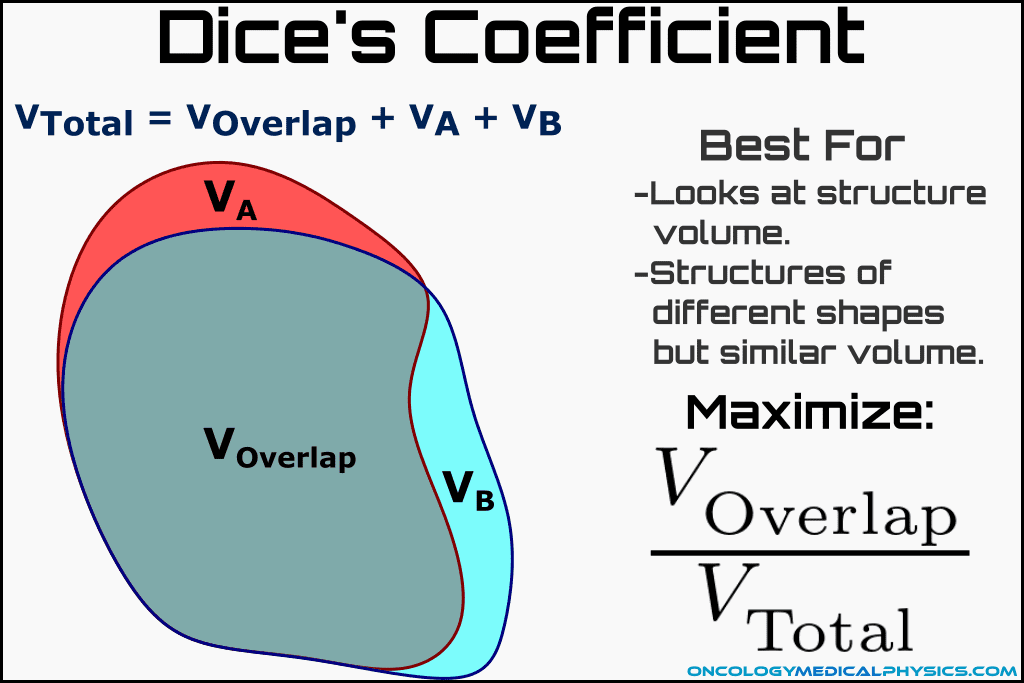Image Registration
Overview
Image registrations are used medically to align two image sets into a common coordinate system. Image registrations are used throughout the diagnostic and radiation therapy process.
Components of Image Registration
Transformation: The method used to align the secondary image to the primary image. Transformations may be either rigid, affine, or deformed.
Similarity Metric: The metric which defines how well the secondary image aligns with the primary image. Similarity metrics may be as simple as a users subjective analysis or a complex scoring method such as mutual information.

Registration Techniques
Image registration technique is defined by the 9 criteria:
- Dimensionality: either 2D or 3D
- Nature of registration basis: either extrinsic (using molds or markers as registration points) or intrinsic (using anatomical features or voxel properties) features to assess the quality of the registration (i.e. the registration metric)
- Nature of transformation: this describes the algorithm which transforms the moving image to align it with the stationary image.
- Interaction: addresses the extent to which the user is involved in the registration. This may be completely manual, completely automated, or somewhere in between.
- Optimization procedure: describes the methods used in manipulating the registration variables to achieve an optimal result.
- Modalities involved: common registration schemes involve a planning CT to a diagnostic CT, PET, SPECT, CBCT, MVCT, or ultrasound image.
- Subject/patient: image registration may be made between images of the same subject/patient (e.g. planning CT and a daily CBCT) or between different subjects (e.g. planning CT and atlas contour set)
- Object/anatomical region: appropriate image registration techinique may vary between objects being registered.
Work cited: Maintz JA, Viergever MA. A survey of medical image registration. Med Image Anal. 2003;2:1-36.
Image Transformations
Rigid Transformation
A transformation technique which preserves the distance between all points on the image. The only allowed operations in the alignment are translation and rotation of the entire image as a unit.
Affine Transformation
A transformation technique which includes the operations of a rigid registration and adds the additional transformations of scaling, sheering and plane reflection. Distance between points in the moving image are not maintained however, parallel lines remain parallel after the transformation.
Deformation
A transformation in which the image can be spatially variant with a large number of degrees of freedom (up to three times the number of voxels in the data set). This transformation can completely change the shape of the object.
Similarity Metrics
Registration metrics quantify the degree to which the pair of registered images are correctly aligned. Several registration metrics are in use and specific implementation of a metric may vary with vendor implementation.
Geometry-based metrics
The most common geometry-based registration metrics use point matching or surface matching. Geometry-based metrics require image processing to assign corresponding points or contours. These points/contours may represent either physical anatomical features (as in atlas-based or manual contouring) or may be an edge defined by a gradient rate or Chamfer matching. With chamfer matching, the image is converted to a binary map (values of 0 or 1) – the edge of which defines the surface.
Point Matching
Point Matching, the difference in the distance separating well defined points in each image are summed and normalized to the total number of such points, as in the below equation where dn is the distance between corresponding well defined points.

Surface Matching
Surface Matching operates similarly to point matching but does not require a defined point by point relationship along each surface. Rather, the metric assesses the squared distance from each point on the surface in image A to the closest on the surface in image B, as in the below equation. d(pn, S)min is the minimum distance from point n on surface A to the closest point on surface B.

Dice's Coefficient
Dice’s Coefficient: A statistical method of comparing the similarity between two samples. It is calculated as the ratio of the overlapping portions of a structure in each image to the total volume of the structure in each image.
![]()
Intensity based metrics
Intensity based metrics, sometimes referred to as similarity metrics determine the similarity of corresponding voxel intensities in an image registration.
Sum of Squared Differences (SSD) seeks to minimize the average squared intensity difference between registered sets.
Cross Correlation (C) seeks to maximize the sum of product of corresponding voxel intensities.
Mutual Information (MI): both Sum of Square Differences and Cross Correlation have difficulties in registering images sets of differing modalities because of the large differences of intensity between the same structure in each image. Mutual information overcomes this limitation by seeking to pair voxels of a given intensity in image A with voxels of a corresponding but uniform, but not necessarily similar, intensity in image B. That is, mutual information is able to consider matching all light voxels in image A to all dark voxels in image B provided that the shape and size of the voxel areas is similar.
Jacobian Determinant
The Jacobian Determinant can be a useful metric for identifying errors in deformable registrations. The determinant identifies local volume change as a result of registration and outputs a numerical value corresponding to the vector field of deformation.
| Jacobian Determinant | Indication |
| >1 | volume expansion |
| 1 | no changes |
| between 0 and 1 | volume reduction |
| ≤0 | non-physical motion (region folded in on itself) |
Knowledge Test
This is the sample version of the full quiz. Log in or register to gain access to the full quiz.
Navigation
Not a Premium Member?
Sign up today to get access to hundreds of ABR style practice questions.






